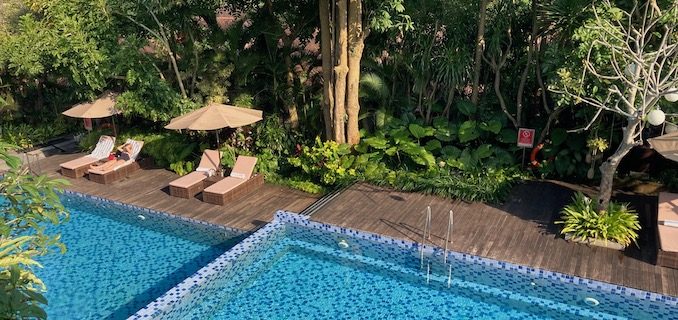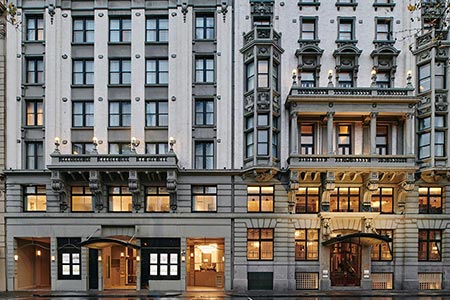
Bali has something for everyone if you choose the right location, travel editor Winsor Dobbin reports, while he also checks out an old Melbourne hotel favourite and somewhere new to try artisan beers in Hobart.
There is one key to getting the best out of Bali: choose your destination with care. If you want to party day and night, Kuta should be your choice. If you are a surf nut, select Uluwatu or hip new destination Canggu.
If you want some time surrounded by terraced rice paddies and art galleries, then head inland to Ubud. If you want to be close to the airport to avoid the traffic, then Nusa Dua and Jimbaran Bay should be in your radar.
For quieter beaches try Lovina on the north coast. Then there are Legian, Sanur and Seminyak – all appealing to different demographics. Do your research on where is likely to suit you best.
Bali is certainly one of the stars of the Indonesian archipelago but try not to cram too much in no matter how tempting another temple or waterfall might sound.
The traffic can be tiresome at peak hours when you could be sipping a cocktail by the pool. Also be prepared for lots of climbing up and down stairs at temples, beaches, even in your hotel.
My recent Bali trip (there will be a full report on the highlights next month) was courtesy of the airasia Superapp and hotel group Archipelago International.
From starting as a budget airline with just two planes, AirAsia has evolved into a fully-fledged travel Superapp and has become one of Asia’s fastest growing travel platforms.
Not only does the airasia Superapp feature the airlines own products, it also offers flights from over 700 airlines, hotels including more than 900,000 worldwide, ride-hailing services, shopping and more. All in the one place.
My flights did not actually involve an AirAsia flight: I flew into Denpasar with Batik Air, and out with Virgin Australia – both booked through the app.
The recently launched suite of airasia Superapp offerings in Bali highlights one of the airline’s key focus destinations for the Australian market. The app is described as a “one-stop shop” powered by data and technology – and has been actioned by 51 million users.
Visitors can engage in real-time conversations, join like-minded communities, play games and much more. The airasia Superapp is well worth a look.
Archipelago International, while not a big name in Australia, is one of the largest hotel management groups in south-east Asia. We stayed at the group’s Aston Canggu Beach Resort in surf destination Canggu and in Royal Kamuela Villas in Ubud (main picture).
They were two contrasting and equally interesting destinations.
The group’s brands include Aston, Alana, Huxley, Kamuela, Harper, NEO, and Fave – so some new names to discover.
See www.archipelagointernational.com. Archipelago has over 40,000 rooms in 200 locations across south-east Asia and other regions.
—

In Europe, older hotels are often the benchmark for style and sophistication.
If you want to take a little step back in time, the Rendezvous Melbourne was built in 1913 and is one of Australia’s most historic hotels.
It has recently undergone a refurbishment to enhance the hotel’s lovely heritage features. One “old school” element, however, shines above all others: the art of hospitality.
The multicultural staff – from the reception desk to the restaurant and the bar – are uniformly smiling, helpful. Downright hospitable, in fact.
Situated just across the road from Flinders Street station, the Rendezvous caters for people looking for a little bit of luxury on budget. Folk from the country in the big smoke for the weekend, perhaps. Or maybe older couples celebrating an anniversary.
The location is great – the vibe equally good.
The modern makeover has retained the century-old charm of what was originally the Commercial Travellers’ Association Building and has gone through several incarnations since – including briefly as a Duxton Hotel.
The original Edwardian building was designed by architect Harry Tompkins, hence the name of the on-site eatery: Mr Tompkins.
Natural lighting and local photography feature in rooms that hark back to the past; while including modern touches like USB slots. The entry level Commerce Room category pays homage to the origins and start from $189 per night.
The Yarra-view Perkins rooms highlight brass and marble and a larger with high ceilings and a bright, airy feel. There are 340 rooms in all, with well-equipped en suite bathrooms.
There is a 24-hour reception, gym, laundry service and fast free wifi. Look out for special deals. https://rendezvousmelbourne.com.au/
—

Hobart’s waterfront Salamanca precinct has a new watering hole with the opening of Manky Sally’s taphouse (above) – another outpost of the growing MONA empire.
The bar is the brainchild of the team behind the oldest and largest craft brewery in Tasmania, Moo Brew, which is part of the empire of MONA boss David Walsh.
Moo Brew managing director Lauren Sheppard, head brewer Jack Viney and head chef Sam Bray are at the helm and Manky Sally’s features its own nano brewery.
The taphouse has over a dozen Moo brew offerings on tap – rotating seasonally – along with a guest Tasmanian brewery offering.
Menu highlights include crispy and delicious báhn mì sliders filled with pate and pickles ($10); chilli and lime whitebait with vinegar salt and chilli mayo ($17); and Xinjiang spiced wallaby on a stick with Sichuan chilli crisp (terrific snacking for $10).
Chef Bray, who has worked at several top eateries, has created a menu that is both fun and very far away from standard pub grub.
Manky Sally’s is at 25 Salamanca Place, Hobart. See https://moobrew.com.au/
See more of Winsor’s travel tips at www.gourmetontheroad.com
